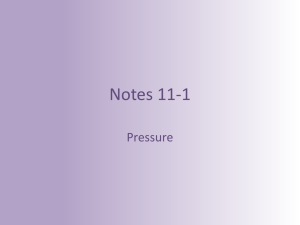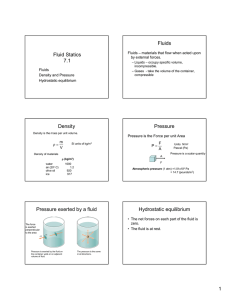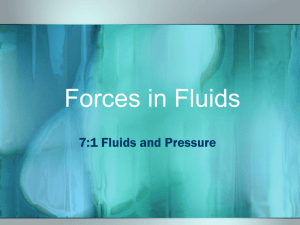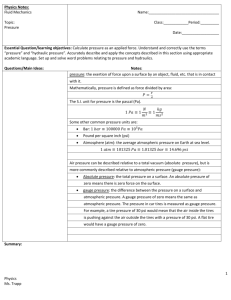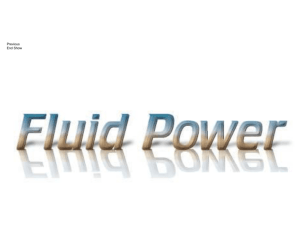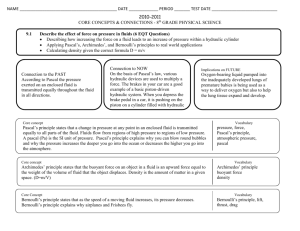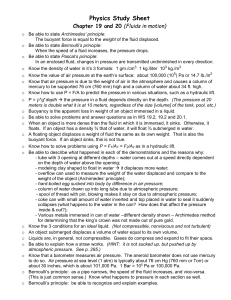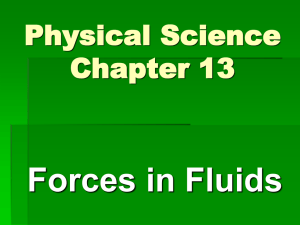Fluid Pressure & Bernoulli*s Principle
advertisement
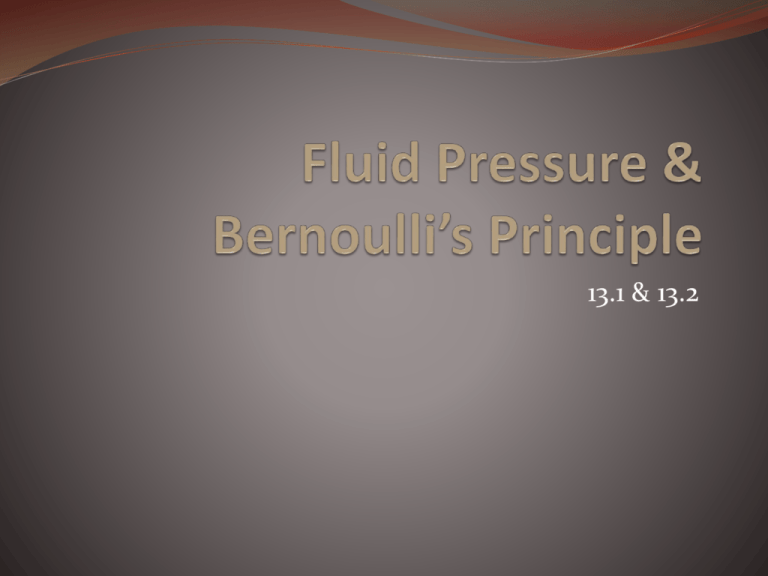
13.1 & 13.2 Pressure Pressure Pressure is the result of a force distributed over an area. • The unit of force is the newton (N). • The unit of area is the square meter (m^2). • The SI unit of pressure is the pascal (Pa). A pascal is one newton per square meter (N/m^2) Pressure Problem If the area of a box touching the ground is 1.5 square meters, and its weight is 2700 newtons, what pressure does the box exert on the ground? Pressure in Fluids Water pressure increases as depth increases. The pressure in a fluid at any given depth is constant, and it is exerted equally in all directions. Pressure in Fluids A fluid is a substance that assumes the shape of its container. • Both liquids and gases are fluids. • Water, oil, gasoline, air, and helium are examples of fluids. Fluids vs Gases A. Particles in a liquid are tightly packed together but are able to slide past one another. Fluids vs Gases B. Particles in a gas are far apart and travel in straight lines until they collide with another particle or object. Fluid Pressure Water in a glass is in contact with the walls and bottom of the glass, Exerts pressure on these surfaces. For a fluid that is not moving: depth and the type of fluid determine the pressure the fluid exerts. Fluid Pressure Each vase holds a different amount of liquid. The liquid levels are all the same because pressure depends on depth, not amount. Atmospheric Pressure The layer of gases surrounding a planet is known as its atmosphere. All of the planets in our solar system have some form of atmosphere. The weight of an atmosphere creates atmospheric pressure at the planet’s surface. Atmospheric Pressure Which planet has the highest pressure? Atmospheric Pressure The bar is another unit of pressure (1 bar = 101.3 kPa). Convert each of the given pressures into bars. Atmospheric Pressure How much force is exerted on a 2.00-square-meter area of Venus’s surface? Atmospheric Pressure On which planet would a balloon filled with a given quantity of helium have the smallest volume? Air Pressure Air pressure decreases as the altitude increases. Earth’s atmosphere exerts pressure of about 101 kPa at sea level. Why aren't you crushed by air pressure? Atmospheric Pressure The pressure inside your body balances the air pressure outside. The balanced forces cancel, resulting in a net force of zero. Pascal’s Principle According to Pascal’s principle: A change in pressure at any point in a fluid is transmitted equally and unchanged in all directions throughout the fluid. Transmitting Pressure Pascal’s Principle A. The forces exerted against the walls of the container are equal at a given depth. B. When squeezed, the pressure is transmitted equally throughout the fluid. Pressure vs Depth At any given depth, equal pressures act against all points on the inside of the bottle. When the bottle is squeezed, the pressure still increases with depth. The pressure increases equally throughout the water. Hydraulic Systems A hydraulic system is a device that uses pressurized fluid acting on pistons of different sizes to change a force. In a hydraulic lift system, an increased output force is produced because a constant fluid pressure is exerted on the larger area of the output piston. Hydraulics The truck uses hydraulic-powered struts to lift its load. The larger area of the output piston produces the increased force. Hydraulics When an input force is applied to the small piston in a hydraulic system, the piston pushes against the fluid sealed in the system. • The pressure produced by the small piston is transmitted through the fluid to the large piston. • The pressure on both pistons is the same. • Because the output pressure acts on a much larger area, the output force is larger. 13.2 Bernoulli’s Principle According to Bernoulli’s principle, as the speed of a fluid increases, the pressure within the fluid decreases. Experiment Try this simple experiment. • Hold a sheet of paper by its top corners. • Position the paper directly in front of your mouth. • Blow over the top surface of the paper. • Can Experiment Bernoulli’s Principle As the air blows across the top of the paper, the pressure exerted by the air decreases. • The motionless air below the paper exerts a greater pressure. • The difference in pressure forces the paper upward. Bernoulli’s Principle Wings and Lift Bernoulli’s principle explains the ability of birds and airplanes to fly. • Air traveling over the top of an airplane wing moves faster than the air passing underneath. • The pressure difference between the top and the bottom of the wing creates an upward force known as lift. Bernoulli’s Principle Air flowing over the top of the wing is diverted up and over the wing’s curved surface. Similar Concept The downward force created by the spoiler on a race car pushes the tires down onto the road, giving the car better traction. Other Uses Spray Bottles Pressure differences between the solution chamber and the moving stream of water draw the solution into the stream.
